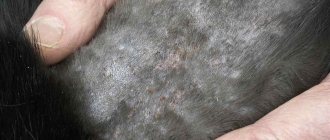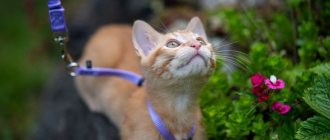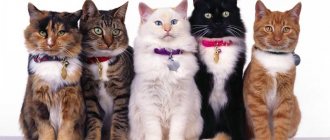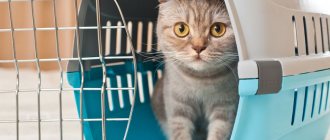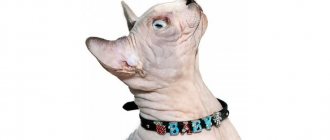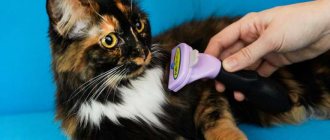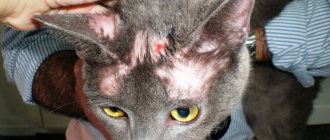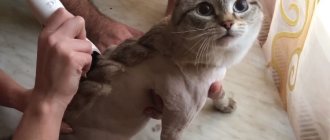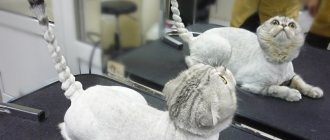In one of our articles, we already explained why cats should be groomed. Of course, this does not apply to all cats, but only to long-haired ones, so owners of smooth- and short-haired cats do not need to read this article.
There is probably no need to explain to cat lovers how important it is to care for the fur of these animals. Proper care will not only keep your cat in good condition, but will also ensure her good health and mood. After all, when a cat has a well-groomed, healthy coat, it not only looks good, but also feels the same.
How to cut long-haired cats.
Grooming a cat is a useful and necessary procedure. Thanks to the haircut, the animal will be freed from the risk of developing tangles, which cause her discomfort and can negatively affect her health. Unfortunately, many cats find the grooming procedure unpleasant (some cats are even given anesthesia to calm them down), but even despite such a reaction from the animal, this procedure is worth it.
Even if the cat's fur is regularly brushed during shedding, a lot of hair will still fall out and spread throughout the house. Grooming your cat can help you avoid this problem. If the cat is trimmed, it will be much easier to comb out the hair during shedding, and it will not spread around the house.
Why do cats get their hair cut?
Owners who groom their cats are guided by the following reasons why they do it:
- The cat is hot in the summer, he suffers.
But the owner apparently doesn’t know that nature provides that wool protects animals not only from cold, but also from heat. A cat's coat provides thermoregulation. Cats do not sweat because they do not have sweat glands, and moisture does not evaporate from the skin, as happens, for example, in humans. The danger is that a pet without a fur coat will simply overheat in the heat and get heatstroke. The skin suffers - it is defenseless against the wind and sun.
- The cat sheds a lot.
All cats, except of course hairless ones, have a lot of hair. Therefore, during the molting period, animals are combed more often. Just because the hairs are cut off, the shedding will not stop or become less. The hairs will become shorter and almost impossible to remove from the furniture.
- I want the cat to be stylish.
An aesthetic hairstyle for beauty is more of a whim of the owner who wants to make the cat fashionable. Model haircuts for cats are given to animals in preparation for an exhibition or photo shoot.
- The cat's fur is matting.
Matted fur is an indication to shave your cat. However, if animals are cut because of mats, then this only means one thing - there is no proper care for the pet. The owner did not teach the cat to brush and bathe. Accustomed to grooming since childhood, the pet humbly endures all grooming procedures.
How often to cut your hair
The frequency of the procedure depends on the length of the cat's fur - the longer, the more often. Cut hair can grow back in 3 months, or maybe in six months. Frequent haircuts can be avoided by more carefully caring for your pet, combing it every evening, bathing it with a special shampoo, and using conditioners to care for the cat’s fur. Experts recommend accustoming animals to grooming procedures from a young age.
A cat should also be cut for diseases such as demodicosis, lichen, dandruff, epiphora and eosinophilic granuloma.
The dangers of haircuts
When looking for an answer to the question of whether cats can be groomed, the pet owner must consider several aspects. The main thing is that a short-haired cat loses important cat qualities. Cats do not tolerate the procedure well. Any haircut is stressful for a pet with all the ensuing consequences.
It is worth considering other points why you cannot cut cats without a good reason:
- After a haircut, the cat does not normally navigate in space.
Whiskers (vibris) in cats are responsible for the sense of touch. Everyone knows this, so they never dare to shave them off. But cats have tactile points not only on their whiskers, but also on their fur all over their bodies. Without them, the animal loses the ability to perceive the environment “correctly.” There are stories of owners when, after shaving, the animal could not move around the house normally until the hair grew back.
- The structure of the coat changes, especially after the machine.
In curly, long-haired breeds, the hair may begin to fluff and become thin, before straight hair begins to curl. Therefore, for example, Persians are cut short only on the stomach and sides.
- Color changes are possible, which is important for show breeds.
When trimming the hair on the back of cats with tipping (tips of hair dyed a different color), color point color, it darkens.
- The fur grows back slowly.
Many owners complain that the cat's hair does not grow after being cut. The fact is that after shaving, the follicles go into the sleep phase and take a long time to emerge from it. The process of restoring fur in young animals takes from 3-4 months to six months, in older animals it takes much longer.
- Protective properties are lost.
Before you cut your cat's hair at home, you should think about the fact that a very short or bald haircut disrupts thermoregulation and deprives your pet of protection from ultraviolet radiation.
Why do you need a haircut and in what cases?
Cats need a haircut for two reasons:
- for health protection;
- for beauty.
It is recommended to trim the following cat breeds with long hair:
- Neva Masquerade;
- ragdoll;
- Norwegian forest;
- Persian;
- Somali;
- Maine Coon;
- Turkish Angora;
- Siberian
Did you know? In Turkey, only Angoras with different colored eyes are allowed to enter the mosque.
It is recommended to give your cat a haircut in the following cases:
- To get rid of cat hair that falls out as a result of shedding and remains on clothes, sofas, chairs, carpets and hands. The cat will still shed, but the fur will be shorter and less noticeable.
- The owners have allergies. A trimmed cat will leave less fluff behind, which can help relieve allergy symptoms.
- To prevent the cat from being too hot in the summer.
- In case of diseases associated with the skin or hair of the animal.
- If a cat is allowed to walk outside, it is easier to notice ticks and fleas in short hair, and it is easier to untangle burdocks from it.
- When the cat is a long-haired breed.
- To get rid of tangles and prevent matted fur in the future.
- After trimming tangles to hide bald areas.
Mats are tangled clumps of hair that often form between the hind legs, near the front legs, under the tail, under the chin of a cat, and occur if the hair is not combed well enough.
They pose a serious threat to a cat's health because:
- They tighten the skin, causing pain and, as a result, stiffness of movement and irritability in the animal.
- Fungi can form in them, fleas can live in them, and in particularly advanced cases, fly larvae.
- There is no ventilation of the skin under them, and it heats up.
- An attempt by a cat to chew out the mat on its own can lead to intestinal blockage and wounds on the skin.
Haircut at home by the owner
You can trim your cat's hair at home yourself. For this you will need:
- a table, ironing board or wide window sill on which the haircut will take place;
- a helper or two to hold the animal;
- cat hair clipper;
- nozzle for this machine 3 mm;
- comb for cats;
- small scissors;
- disinfectant (for example, hydrogen peroxide).
Important! Optimal length of a cat's cut hair
-
3 mm, it will not prick, will be softer and will not allow the sun to burn the animal’s skin.
The people who will help you should hold the cat firmly by the paws and press the body to the surface so that it does not escape, injure itself or scratch anyone. It is important not to overdo it and not damage the animal’s paws or body. Cats do not take a haircut well, so they will not only actively resist, but also meow loudly, growl, and beat their tail, trying to intimidate you or make your heart clench with pity.
If there are tangles, they must be cut out first. This can be done at the root, but very carefully - in thick wool it is easy not to notice that the fur has already ended and the skin has begun. Another method is safer; you need to cut the tangle lengthwise several times and gradually comb it, starting from the ends. The animal must be placed on its side and the hair on the back, sides and tummy must be carefully trimmed. Then the cat (cat) needs to be turned over and trimmed on the other side.
This procedure is often used specifically for long-haired cats, especially Nibelungs, Persians, Himalayans, Scottish and Somali cats.
On the stomach you should be especially careful not to damage the nipples and genitals. Most often, the hair on the paws is not cut, only up to the joint. When cutting, stretch the skin so that it does not create folds, otherwise injury cannot be avoided. If you accidentally injure an animal, the wound must be treated. After the procedure, the cat must be bathed so that the cut hairs that do not fall off do not prick it.
Did you know? For 1 sq. There are about 20 thousand hairs per cm of cat hair.
Haircut by a groomer
It is recommended to have cats' fur trimmed by professionals; they will do it faster and will not injure the animal. Grooming of cats is their haircut and other procedures related to a healthy appearance, translated from English as “care”.
Grooming specialists offer:
- model haircuts;
- bathing and grooming;
- flea treatment;
- nail care;
- eye care;
- ear care.
A grooming professional can perform treatments at home, in a specialized salon, or at a veterinary clinic.
Opinions differ on where it is best to do this. Some people think that it’s better at home, cats feel calmer in a familiar environment, so the grooming will take place without problems; others - on the contrary, that feeling like masters in a home environment, they will resist, but in an unfamiliar place, on the contrary, they will allow themselves to be manipulated. Find out more about what grooming is, a furminator comb, and whether your cat’s claws need to be trimmed.
Why do you really need to groom cats?
Cats that are groomed are mainly of long-haired breeds: Persians, Maine Coons, Siberians, Norwegian Forest, etc. In animals with long hair, if not properly cared for, this becomes a necessary procedure.
There are several reasons why cats need to be groomed:
- Tangles
Almost all long-haired cats suffer from matted fur. The tangles form gradually. If the owner does not feel them in time and does not untangle them, then a matted “felt boot” will appear on the pet’s body. Due to the tight fur, the mat causes discomfort to the pet and the skin itches. The lump quickly becomes an attractive place for parasites. Over time, it can lead to alopecia.
Tangles should absolutely not be cut with scissors, especially in the armpits and groin area - it is easy to injure your pet. The skin there is very thin, it can be difficult to understand where the tangle ends and the skin begins. After being hurt, a cat will stop trusting its owner and may become aggressive. First they try to comb the tangles, then cut them with a special device - a tangle cutter.
- Age and health status
It is difficult for old, sick, or overweight animals to take care of themselves. In this case, a haircut makes life much easier for your pet.
- Bezoars
Cats are clean, but when licking, they swallow a lot of hair. The hairs in the stomach form hair balls, which cause the cat to vomit. Hairballs are dangerous due to intestinal blockage.
- Dermatological problems
Dermatitis, fleas, greasy tail, increased secretion of the sebaceous glands are indications for hygienic grooming of cats.
Cat Hairstyle Trends
There are many models of fashionable haircuts. Basically, the choice depends on the imagination of the groomer or owner, and the characteristics of the breed.
However, there are several main options for cats that have become classics (see photo):
- A lion. A common hairstyle for Maine Coons and other large breeds: Norwegian Forest cats, Siberian cats. The fur on the body and legs is cut short (0.5 cm), remaining on the head, neck, chest, and tip of the tail. A lion haircut is considered both hygienic and fashionable. However, in the latter case it may not always turn out beautifully, especially if the hair tangles behind the ears.
- Puma. The hairstyle is similar to a lion, only the fur coat remains on the front part of the body and front legs. They also form socks on the hind legs, leaving a tail or its tip. The back of the body is trimmed with a machine. The hairstyle received another name - “sheepskin coat”.
- Puss in Boots. The hairstyle is similar to a lion, but there is no mane.
Lion and cougar are considered basic cat haircuts, but they have several options for tail and paw treatments:
- Christmas tree. The base of the tail is cut, then 2 more small sections at equal intervals. The result is 3 triangles.
- Squirrel. The tail remains fluffy and is shaped using thinning scissors. Only the base of the tail is trimmed.
- Brush. The size varies depending on the wishes of the owner. The shape of the tip does not change.
- Broom. The same as a brush, only the edge of the tip of the tail is cut straight.
- Knee socks - up to the middle of the paw are cut with a machine, the rest is formed with scissors.
- Socks are a shortened version of golf.
Additionally, it is possible to cut various patterns. For example, the Dragon or Dinosaur hairstyle in different versions is considered popular. The cat turns out to be completely shaved. Only the mohawk, stepped comb, stripes, and teeth are left on the back. The tail is either patterned or like a lion haircut.
Manual typewriter
To quickly and accurately cut cat hair, ordinary scissors are not enough; you will need a powerful clipper. The width of the blade is selected depending on the size of the animal. The sharpening must be of high quality, otherwise the device will have to be given to the master after each haircut, because you cannot straighten the blades yourself.
A clipper for cutting fluffy cats - Persian, Siberian and others - must have a power of at least 45 W. A weak machine will not cope with thick hair. For ordinary cats, 20 W is enough power.
For home use, a machine powered by the network is better suited. There are 2 types of motors - rotary and vibration. The rotary motor is more powerful, it copes well with thick hair, but it also costs more. A rotary motor overheats faster. If the cooling is done poorly, which happens with cheap clippers, then you will have to stop while cutting. A vibration motor overheats less, but is inferior in reliability to a rotary motor.
The cat clipper should fit well in your hand. A model that is too heavy will be tiring to use, while a light one will “walk around.” Choose the golden mean.
There is an alternative to electric clippers - a manual clipper. This tool resembles scissors or pruning shears and is operated by pressing the handles. A manual clipper is suitable for shy cats because it does not make any sounds. You can cut your pet's hair unnoticed by disguising the actions with caresses or even in a dream. The machine is easy to clean and cannot be broken. Another advantage of a manual typewriter is its low price.
But there are also disadvantages - the duration of a haircut increases significantly, and without certain skills, not everyone will be able to cut a cat’s hair neatly and evenly right away. A manual clipper is suitable for hygienic haircuts at home, but not for cutting before an exhibition or surgery.
Haircutting tools
Before you cut your cat's hair at home, you need to get some tools.
Trimming fur with office scissors usually takes a couple of days. As a result, something globby is walking around the house.
Scissors are used only for improvement and shaping. The main tool, including when grooming a cat yourself, is a clipper.
Cats are distrustful of new objects, and if it still buzzes or vibrates, it strikes fear in the cat’s soul. For timid people, a mechanical machine is suitable.
This device is a pair of scissors with special blades and a spring in the center of the handles. After pressing the handles, the blades converge, cutting the hairs, then the handles spring back, the blades diverge.
What you need to know before cutting your cat's hair
There are several things you need to know before cutting your pet's hair. Grooming is not suitable for all cats and can have unexpected consequences.
- The texture of the coat and its color can be permanently changed after clipping.
- There are breeds and colors that should never be cut - cats with tipping and color points. The cat will look completely different after the haircut. The animal's fur will darken, and the cat will forever lose its natural coloring.
- In some cases, the fur takes a very long time to grow and may never reach its previous length.
- The hair on the ears and head cannot be cut, the same goes for the mustache.
- If the cat becomes agitated and struggles, muscle relaxants can be used to limit the cat's mobility and reduce muscle tone.
- Aggressive and violent animals are immobilized using anesthesia. This carries some risk and is not suitable for older animals.
- Sedatives, muscle relaxants and anesthesia can only be prescribed by a veterinarian. You cannot use them on your own at home.
We invite you to read: Hepatovet for cats: instructions for use and dosage, side effects, analogues
Haircut in the salon
It is difficult to make a model hairstyle at home without certain skills. It's easier to contact a groomer. But this has its own characteristics. You can’t trust salons that groom cats under anesthesia. This makes life easier for workers, but the procedure has many disadvantages:
- An ECG is necessary to rule out heart problems.
- Only a doctor should give the injection. Incorrect dosage can be fatal.
- Harmful effects on the body, which provokes the appearance of various pathologies.
Some salons say that they do not use anesthesia, but use muscle relaxants to groom aggressive animals. However, the drugs immobilize, but the cat understands everything and feels discomfort and pain. This is a lot of stress on the animal. If you cut a cat's hair using injections of muscle relaxants, then over time it will no longer be possible to carry out the procedure without the drug.
For the above reasons, you need to look for a groomer who is looking for an approach to pets and does without anesthesia.
How to cut a cat's hair at home: preparation
Grooming cats is a labor-intensive procedure. But not all cat owners have the opportunity to contact a groomer.
When thinking about how to cut a cat’s hair at home, it is important to consider the following:
- The cat has claws that he will definitely use. Therefore, preliminary trimming of the claws is mandatory.
- You won’t be able to do a model’s hairstyle correctly at home without experience or knowledge.
- Haircutting at home is not a quick process. The master takes from 40 minutes to 3 hours, for some owners it takes 2-3 days.
- Without an assistant, only a very calm cat will be able to cut the hair on his own. Generally, cats are aggressive, especially when they start being groomed. They do not hear commands and cease to understand that the owner is next to them.
For a haircut you will need:
- Table or ironing board. Some people groom cats in the bathroom.
- Any antiseptic in case of a wound.
- A damp towel to dry your cat afterwards.
- Soft brush for combing. Hard brushes can injure and frighten the cat.
- Ordinary combs with thick and sparse teeth.
- A trimming knife or tangle cutter if you need to remove tangles.
- Ordinary and thinning scissors.
- Machine.
Algorithm of actions
In order to cut your cat’s hair for the first time without difficulty, you need to clearly understand what exactly needs to be done and in what order.
- If you are trimming your pet's nails, start here.
- Lay the animal on its side, hold its hind or front legs - an assistant can do this.
- Turn on the machine away from the cat, let it get used to the sound in advance to avoid severe fright.
- If the cat is very frightened, bites and actively breaks out, secure it; you can put a plastic cap on its head to avoid being bitten.
- Remove matted wool and tangles using scissors.
- Start cutting from the sides and back.
- The skin needs to be stretched to avoid injury.
- Be especially careful when clipping belly hair - don't forget the nipples.
- If you cut in the direction of hair growth, it will be longer, if you cut against it, it will be shorter.
- Choose a nozzle from 3 mm; a shorter one may injure the cat.
- Don't cut the paws completely, leave on the knee socks.
- There is no need to cut your head.
- The tail may not be cut at all or the hair may be left at the tip.
- At the end of the haircut, carefully trim the head, paws, and tail with thinning scissors.
- If necessary, trim the fur between your fingers.
- Remove any remaining clipped hair with a wet towel or wash the cat.
- Dry the wool with a hairdryer.
How to cut a cat's hair with a clipper
How to cut a cat's hair is a whole course of science, but which you can master on your own.
Recommendations from professionals when cutting hair yourself at home with a clipper:
- For aesthetic and hygienic haircuts, the best option is a 3 mm knife. This knife leaves hair 3 mm long. The wool is soft and plush to the touch. In some cases, they shave shorter (1-2 mm). But the fur becomes prickly and will take at least 10 days to grow back to a plush state.
- It is better not to use attachments - hair gets tangled in them.
- When using larger knives (No. 5.9), unevenness remains and the wool becomes wrinkled.
You can't cut:
- The hair on the head is dangerous, there are many glands and receptors that can be easily damaged.
- Hair in the ears. They protect the ear canal from dust and foreign objects.
